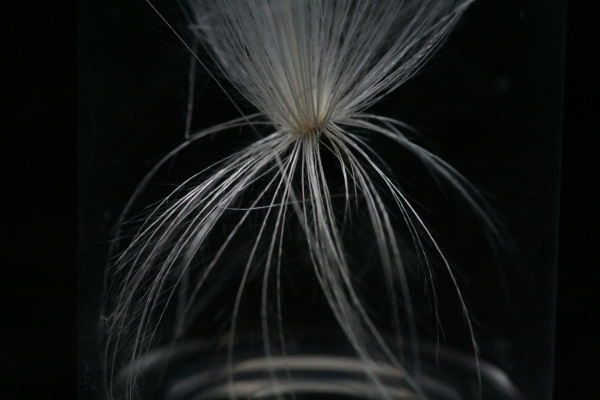
Create a selection
No summertime countryside ramble would be complete without a playful puff on a 'dandelion clock' to disperse these delicate dandelion parachutes. Before their removal and capture in this jar, these seeds would have been loosely attached to the head of a dandelion stalk at their base, bundled together in a translucent sphere of tempting fluff. A breath of wind – by origin of meteorology or mouth – provides enough force to detach the seeds, which hope to glide large distances through the air to germinate elsewhere.
But don’t be fooled by these seeds’ nostalgic charm – they are ingeniously-engineered flying machines. Each individual seed is connected by a long umbrella-like rod to a canopy of around 100 extremely fine hair-like filaments called a pappus, from the Ancient Greek pappos and Latin pappus, meaning 'old man'. The weight of the seed keeps the pappus upright and balanced, and like a parachute, the pappus increases aerodynamic drag to slow the descent of the seed.
The exact arrangement of the bristles in the pappus also allows for airflow between them, which forms a unique type of vortex ring in the surrounding air. This donut-shaped ‘toroidal’ vortex is similar in shape to a smoke ring, and produces an area of low pressure above the pappus as it flies, providing an invisible boost to the forces of lift acting on the seed, and allowing it to fly kilometres further afield.
If that wasn’t impressive enough, the pappus is able to control when it is dispersed, depending on the suitability of conditions for seed propagation. It does this by changing shape in response to the presence of moisture in the air. In favourable conditions, the pappus morphs to become maximally buoyant, whereas in less promising weather, it closes up to avoid being lifted by its special vortex until the situation improves. The pappus of the dandelion has been studied by scientists intent on biomimicry: learning from and mimicking strategies found in nature to solve human design challenges, including efficient liquid transport and delicate airflow detection in neonatal incubators.
Sample ID: 923
Particularities
- State
- Solid
- Compound
- Found
- Swiss Alps
- Selections
- Nature's Engineers
- Categories
- Vegetable
- Curiosities
- Biomimetic
- Relationships
- Aerodynamics | Biomimetic | Dispersion | Filament | Fluffy | Hair | Light Weight | Natural | Natural structure | Seed | Vortex
Add materials you find interesting to your own selections.
Use the  button to select a material and get started.
button to select a material and get started.


